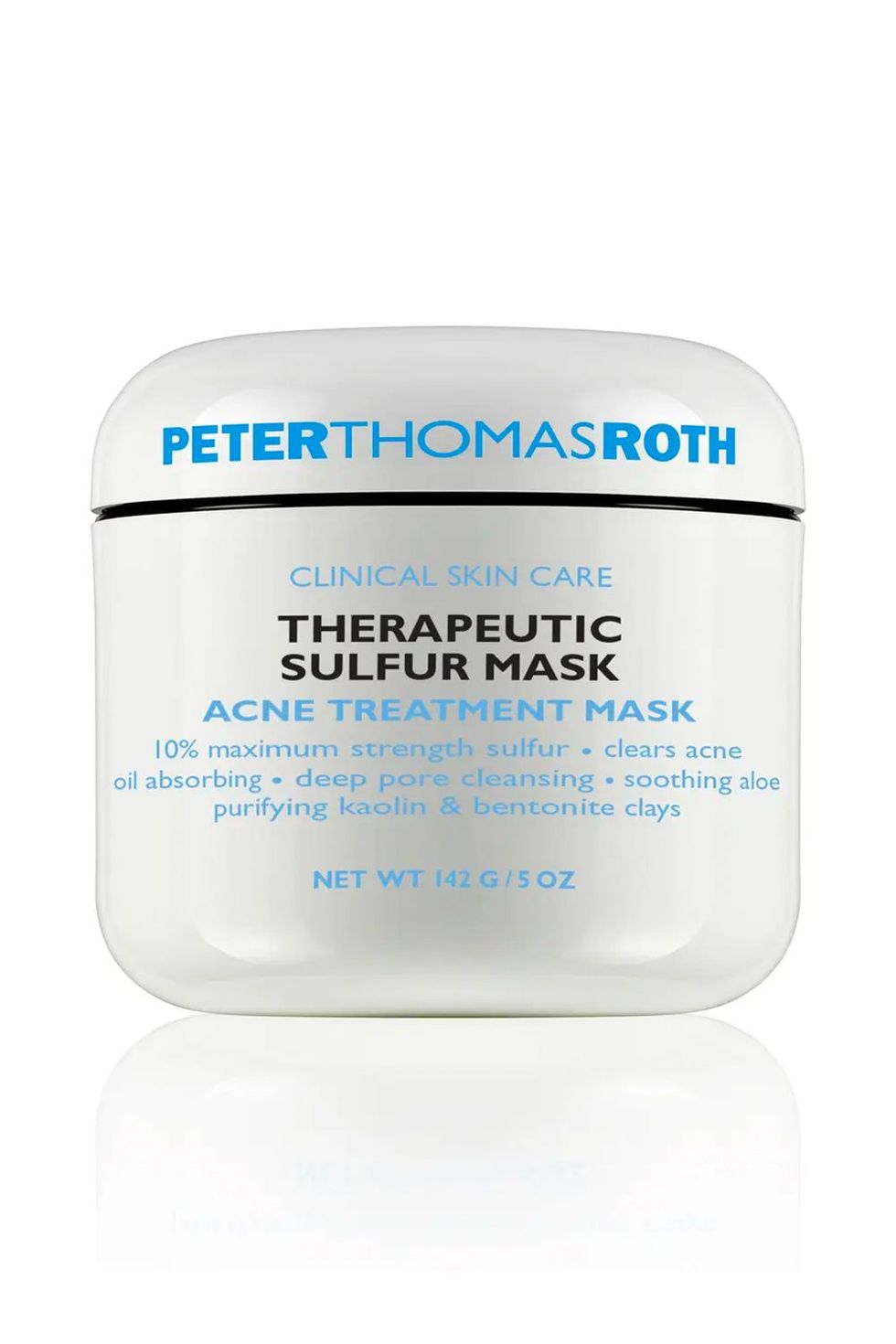When we think about acne, most of us picture whiteheads along the cheeks, or hormonal breakouts on the jawline. And while the face often plays host to these unwelcome guests, the truth is you can actually get a pimple anywhere on your body, including your neck. Yep, neck acne is very much a real—and common—thing. “Acne or acne-like breakouts on the neck can look just like acne anywhere else on the face or body,” explains dermatologist Libby Rhee, MD.
But unfortunately, the causes of neck acne go well beyond the usual hormone and stress-related suspects, and treating breakouts on your neck’s delicate skin can be complicated if you don’t know what you’re doing. But it’s not all bad news: If you’re experiencing neck acne, you’ve got plenty of options when it comes to treating it. Read on to discover what may be causing your neck acne—plus the expert-approved tips and tricks from Dr. Rhee and dermatologist Alan Parks, MD, for getting rid of it ASAP.
What are the most common types of breakouts on the neck?
Just like on your face, you can get many different types of acne on your neck. “Inflammatory lesions such as papules, pustules, and cystic acne are more common than comedonal lesions like blackheads and whiteheads, although a combination can occur anywhere,” says Dr. Rhee. Razor bumps and ingrown hairs, both of which look like zits, are also common on the neck, and for women, hormonal acne can also commonly occur on the neck as well, adds Dr. Rhee. These types of breakouts are typically more painful than blackheads and whiteheads since they're deeper under the skin and inflammatory in nature.
What are the main causes of neck acne?
Acne on the neck is typically triggered by the same things that trigger acne on the face. It’s often caused by a combo of inflammation and an overactive oil glands resulting from genetics or hormones, says dermatologist Alan Parks, MD. On top of that, using the wrong skincare products or the wrong ingredients for your skin type can lead to clogged pores and/or inflammation, which, you guessed it, can cause neck acne too. And like everywhere else, the neck can breakout as a result of stress.
But neck acne can also have specific triggers because of its location, and friction from clothing or accessories, shaving, excessive sweating, or comedogenic haircare products are often to blame. “Many times, neck acne can form when your hair, with its various oil-based products, rubs against the neck or when jewelry or clothing interacts with sweat on your neck, causing a reaction,” Dr. Rhee explains.
Can certain clothing cause neck acne?
We hate to say it, but it’s possible that your favorite turtleneck sweater or workout top could be the source of your neck acne. “Wearing clothing that is too tight too often can cause a reaction on the skin, leading to irritation and potentially causing breakouts,” Dr. Parks says. “Additionally, wearing synthetic, non-breathable fabrics, such as polyester or neoprene, can contribute to neck acne,” Dr. Rhee says. “Clothing or accessories, like a helmet with a chin strap, clothing with a high collar that rubs on the neck, and irritating or sweat-inducing scarves, can lead to unwanted acne in this area too.”
Also important to know: Working out and leaving your sweaty clothes on too long can give acne-causing bacteria an environment to thrive and cause acne. To avoid this, it’s important to change out of your exercise gear right after a workout and rinse off with a gentle body wash so sweat and bacteria doesn’t sit on your skin.
How do you get rid of neck acne?
The good news is that even if your neck acne is caused by something specific, you can still turn to the same at-home and in-office remedies you’d use on your face. “Similar to acne on the face, ingredients like benzoyl peroxide, salicylic acid, and sulfur are great clearing out pores, reducing inflammation, and killing acne-causing bacteria,” says Dr. Parks.
If you have active breakouts on your neck, it can also be helpful to alternate between using an acne-specific wash, like PanOxyl’s 4% Acne Creamy Wash or Murad’s Acne Body Wash, and an exfoliating cleanser in the shower, in lieu of a traditional body wash. “It's also important to keep your neck moisturized when using these ingredients and to apply sunscreen with SPF 30 or more too,” adds Dr. Parks.
There are also several prescription medications that can be used to treat neck acne. Retinoids (like Twyneo, Altreno, and Aklief) are excellent at treating acne, but can cause dryness, flaking, and irritation—especially on thin neck skin. If your skin can't tolerate a retinoid for acne, Dr. Rhee suggests incorporating Rx-strength azelaic acid into your body care routine instead. "The ingredient can really help because it effectively decreases inflammatory acne or folliculitis-related breakouts in a gentle way,” Dr. Rhee says.
In addition to these at-home solutions, you may find an answer to your neck acne woes in the form of an in-office treatment. “In my experience, a combination approach including chemical peels, resurfacing lasers like Fraxel, and microneedling, along with radiofrequency-based devices is most effective for combating acne and scarring both on and off the face,” Dr. Rhee says. “But it’s important to remember that what’s best will be different for each person, and having a personalized consultation with someone who understands your skin and your goals is essential since any treatment meant to improve scarring can also cause unwanted scarring if planned or done incorrectly.”
Are neck acne and bacne the same thing?
At a high level, all body acne forms from the same set of factors and can look the same, but neck acne and back acne, or bacne, can each have triggers specific to their location. “For example, clothing rubbing on sweating skin can cause clogged pores and irritation on both the neck and back, but may be more prevalent where your sports bra rubs,” Dr. Rhee explains. The neck is also more susceptible to acne caused by oil-based hair products or friction from jewelry.
“You'll typically see the same types of breakouts on your neck and back, depending on your lifestyle and skin type, but things like sweat, hair products, or tight clothing can affect the presence of acne on your back or neck,” Dr. Parks adds. “So, be sure you're always cleaning your entire body and visiting your dermatologist if you have any concerns.”
The takeaway:
Although the neck isn’t always the first place we think of when it comes to acne, it’s just as prone to breakouts as any other part of the body, if not more. Acne of all forms can appear on the neck, but the more painful pustules, papules, nodules, and cysts are especially common here and can be more challenging to get rid of.
These breakouts can be caused by a number of factors, from hormonal imbalances and stress to comedogenic hair products and even certain clothing. Like acne on the face, neck acne can be treated a number of ways using acne-fighting products and prescription medications at home or undergoing microneedling, laser resurfacing, chemical peels, and other treatments at your dermatologist’s office.
Meet the experts:
- Libby Rhee, MD, is a board-certified dermatologist at Liora Dermatology in New York, NY, and the dermatologist in residence for the telehealth company Ro. Dr. Rhee and her team specialize in all types of medical and cosmetic dermatology, from acne and eczema treatments to facial fillers and lasers.
- Alan Parks, MD, is a board-certified dermatologist at Eastside Dermatology in Columbus, OH, and the founder of online skincare retailer DermWarehouse. He treats a full range of skin conditions and has received the American Academy of Dermatology Community Service Award for skin cancer screening and the Edmund D. Lowney Teaching Award for teaching dermatology residents.
Why trust Cosmopolitan?
Gabby Shacknai is a New York City-based journalist with years of experience researching, writing, and editing beauty and wellness stories. Gabby is an authority in all skincare categories, but is an expert when it comes to acne. She works with the industry’s top dermatologists to assess new acne treatments, products, and medications.

Gabby Shacknai is a New York-based journalist and editor who produces high-quality content for a wide variety of outlets and brands across various industries.

















